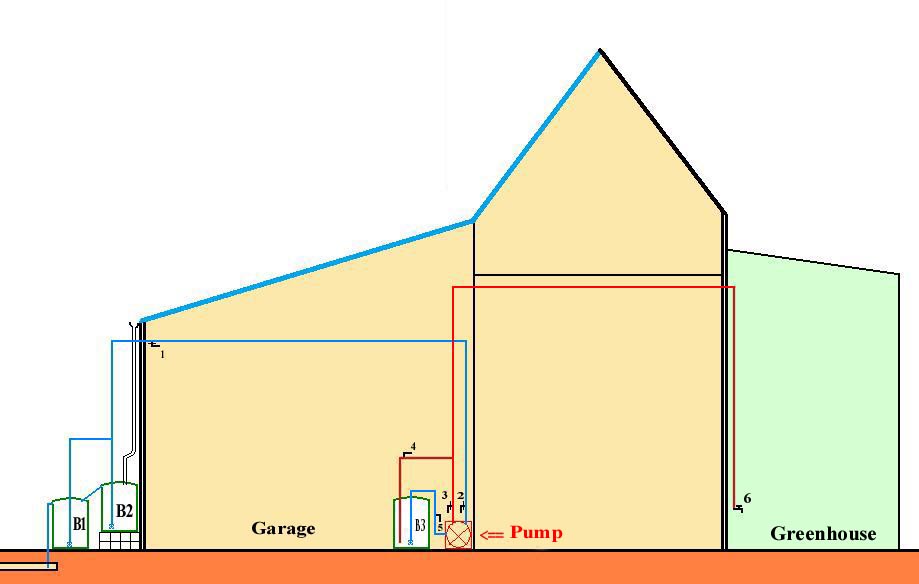**** THE WATERING INSTALLATION ****
**** OF MY COLLECTION ****
Page 1/5
A long time ago, more than twenty years, I
began my collection of cacti which only consisted then inten pots. Concerned
as I was about the health of my plants, I had decided to water them
only with Volvic water (well-known French spring water). Which led
me to go and buy six 1.5-liter-bottle packs, approximately once every two
weeks. Until then, everything seemed reasonable.
But that did not take into account the too-frequent and badly-controlled phenomenon
of the increase of the size of a collection. Don't laugh, I am not the only
one !
I understood very quickly that my method was to be replaced by
another one, easier and cheaper at least in the long run.
As the epiphytic cacti especially do not like calcareous water, I decided
to water my collection with rainwater gathered from the roof of my
house. The numerous bottles in which I transported water to my plants
quickly became inconvenient and I decided to adopt an easier method.
I asked my plumber if he could imagine an installation which would enable
me to water my plants with a watering pistol and rainwater,
the great luxury !
And thus, approximately 15 years ago, was born the installation which I am
going to show you, which always functions very well and which limits are not
felt in spite of the size of my collection, which begins to overtake me…
Here is the brief diagram before returning a little
more in the details:

I collect rainwater which falls on the part of my
roof drawn in blue; this part has a surface area of approximately
90 m². The rainwater flows in two outdoor rainwater barrels
B1 and B2; the vertical drainage pipe of rain leaves the gutter to fill B2
barrel; when B2 is full, it supplies B1 barrel via a small oblique pipe. When
B1 barrel is also full, a small flexible tube similar to the first one evacuates
the excess water into the underground network of evacuation of rainwater.
The capacity of each barrel being approximately 200 liters, I can thus have
an outdoor reserve of 400 liters of water.
But it happens that the winter temperatures transform this water into ice
and thus make any watering impossible. However, I continue to water
my epiphytic cacti during the winter, at the rate of once every
three weeks to one month, depending on the weather.
So, I put a third B3 200 liters barrel in my garage
which is almost always free of frost; the water of this barrel is always available.
This barrel is supplied by the two outdoor ones by the way of an electric
pump which ensures both the filling of this B3 barrel as well
as the routing of rainwater under pressure to my greenhouse, via an indoor
piping, which is not submitted to frost, except for a small portion in my
garage.
On the pipes I had six taps installed, numbered from 1 to 6 on the diagram.
Taps 1, 2 and 3 are provided with drain cocks which
make it possible in winter, to empty the piping (made of copper) between taps
1 and 2 essentially, and between taps 3 and 6 occasionally, all this to avoid
exceptional frost and to reduce the pressure in the pump, when is at rest.
I already had accidental frost in my garage, the piping being fragile at the
taps especially, as well as at the pump.
The pipes drawn in blue make circulate the water of the barrels
towards the pump (except for the oblique pipe between B1 and
B2 and of the pipe which evacuates the excess water of B1); those
which are drawn in red make water circulate either towards B3 barrel, or towards
my greenhouse where I connect the watering pipe to tap 6.
The use of drain cocks 1 and 2 makes it possible to protect the most significant
parts of the piping from frost and to continue to water during the winter,
even when the external barrels are frozen, by using only the indoor B3 barrel
which I refill when the temperatures rise again.
And here are now some additional precisions, by using some photographs with
accompanying notes.
ENTER THE SERIES OF PHOTOGRAPHS
________________________________________________________________________________________
SUMMER-WINTER FITTING OUT OF MY COLLECTION
________________________________________________________________________________________________